research
-
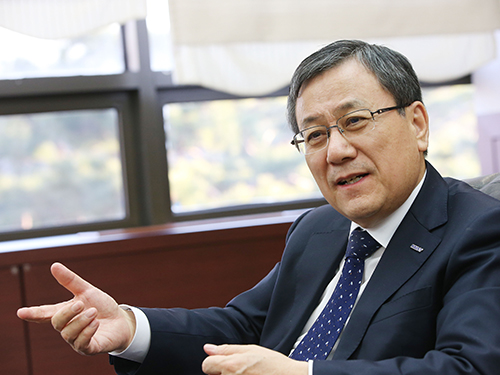 President Shin to be Honored from Northwestern University
(KAIST President Sung-Chul Shin)
President Sung-Chul Shin has been named the recipient of the Distinguished Career Achievement Award 2019 for Alumni of Materials Science and Engineering at Northwestern University.
The awards committee announced last month that the committee decided to award President Shin in recognition of his significant contribution toward materials research, particularly in the field of magnetic materials, and also for the leadership he has demonstrated in higher education. The awards ceremony will take place on May 16 at Northwestern University.
President Shin earned his PhD in material physics at Northwestern in 1984 after completing his MS in condensed matter physics at KAIST in 1977. He is also a graduate of applied physics from Seoul National University.
President Shin, an accomplished scholar in the field of nanoscience and a pioneer of research in nanospinics, has held numerous fellowships including the American Physical Society and received scholarly honor from the Asian Union Magnetics Societies. His research focuses on the artificial synthesis and characterization of nonmagnetic materials, magnetic anisotropy, and magneto-optical phenomena. While studying at Northwestern, he produced novel superlattice multilayer thin film structures with bismuth and lead telluride, noting that they have similar structures.
With his expertise, he joined KAIST in 1989 to dedicate himself to academic contributions. During his professorship in the Department of Physics, he produced about 300 journal papers and 37 patents while fostering 80 graduate students. He served as the first president in Daegu-Gyeongbuk Scientific Technology Research Institute (DGIST) for six years from 2011.
2019.01.09 View 4017
President Shin to be Honored from Northwestern University
(KAIST President Sung-Chul Shin)
President Sung-Chul Shin has been named the recipient of the Distinguished Career Achievement Award 2019 for Alumni of Materials Science and Engineering at Northwestern University.
The awards committee announced last month that the committee decided to award President Shin in recognition of his significant contribution toward materials research, particularly in the field of magnetic materials, and also for the leadership he has demonstrated in higher education. The awards ceremony will take place on May 16 at Northwestern University.
President Shin earned his PhD in material physics at Northwestern in 1984 after completing his MS in condensed matter physics at KAIST in 1977. He is also a graduate of applied physics from Seoul National University.
President Shin, an accomplished scholar in the field of nanoscience and a pioneer of research in nanospinics, has held numerous fellowships including the American Physical Society and received scholarly honor from the Asian Union Magnetics Societies. His research focuses on the artificial synthesis and characterization of nonmagnetic materials, magnetic anisotropy, and magneto-optical phenomena. While studying at Northwestern, he produced novel superlattice multilayer thin film structures with bismuth and lead telluride, noting that they have similar structures.
With his expertise, he joined KAIST in 1989 to dedicate himself to academic contributions. During his professorship in the Department of Physics, he produced about 300 journal papers and 37 patents while fostering 80 graduate students. He served as the first president in Daegu-Gyeongbuk Scientific Technology Research Institute (DGIST) for six years from 2011.
2019.01.09 View 4017 -
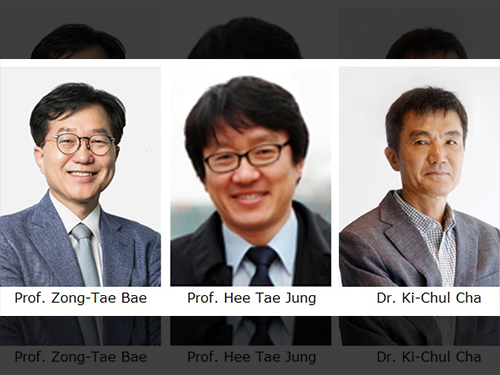 NAEK Announces the New Members
The National Academy of Engineering of Korea (NAEK) announced its 42 new senior members and 61 new members who are actively engaging in academia and industry.
Professor Zong-Tae Bae from the College of Business and Ki-Chul Cha, the head of the KAIST Alumni Association and the CEO of Inbody were appointed as senior members of NAEK while Professor Hee Tae Jung from the Department of Chemical and Biomolecular Engineering was elected as a member of NAEK.
NAEK is a corporate body specializing in engineering. It is involved with promoting industrial competence and fostering human resources. Every year, it holds membership voting to select senior members among the members who demonstrated excellent research performance in universities, institutes, and companies.
To be elected to NAEK is quite prestigious, and considered as the highest professional honor in the engineering field. NAEK confers membership to those of who have more than 15 years of career experience. After a thorough evaluation, a member can be elevated to a senior member.
As of January 2019, NAEK has 285 senior members, 343 members, 432 emeritus members, and 71 foreign members.
2019.01.08 View 4003
NAEK Announces the New Members
The National Academy of Engineering of Korea (NAEK) announced its 42 new senior members and 61 new members who are actively engaging in academia and industry.
Professor Zong-Tae Bae from the College of Business and Ki-Chul Cha, the head of the KAIST Alumni Association and the CEO of Inbody were appointed as senior members of NAEK while Professor Hee Tae Jung from the Department of Chemical and Biomolecular Engineering was elected as a member of NAEK.
NAEK is a corporate body specializing in engineering. It is involved with promoting industrial competence and fostering human resources. Every year, it holds membership voting to select senior members among the members who demonstrated excellent research performance in universities, institutes, and companies.
To be elected to NAEK is quite prestigious, and considered as the highest professional honor in the engineering field. NAEK confers membership to those of who have more than 15 years of career experience. After a thorough evaluation, a member can be elevated to a senior member.
As of January 2019, NAEK has 285 senior members, 343 members, 432 emeritus members, and 71 foreign members.
2019.01.08 View 4003 -
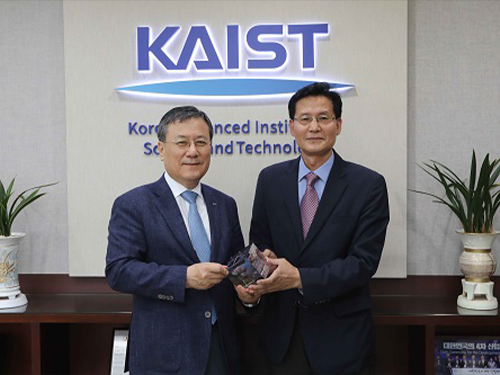 AST Holdings Makes a Donation to KAIST
(KAIST President Sung-Chul Shin and the CEO of AST Holdings, Haegyoo Seo)
KAIST President Sung-Chul Shin and the CEO of AST Holdings, Haegyoo Seo, agreed to a partnership on June 27 at the main campus of KAIST.
AST Holdings donated one hundred million KRW to the school for fostering experts in the field of augmented reality (AR). The fund will also go to joint research on AR technologies required smart cities.
AST Holdings, established in 1997, specializes in developing VR/AR contents. It has collaborated with Samsung Electronics and KIA Motors to produce various digital contents and develop solutions using VR/AR.
Research and development carried out by the Augmented Reality Research Center (ARRC) of KAIST aims to foster talented manpower and has accumulated crucial components of technology for contributing to research dissemination.
In particular, the ARRC established an industrial, academic, and research partnership that has suggested a new standard for industrial-academic joint research. Under this agreement, an industry assigns its staff to the research center to obtain new technical capabilities while the center strengthens the technological application of a study based on the industrial needs.
Through the partnership funds, the center can provide a stable research environment for young researchers and recruit talented manpower from around the world. The center has the potential to become a new model of industrial-academic research platforms that will take a leading role in the field of VR/AR.
CEO Seo said, “I would like to take the lead in research on VR/AR-based futuristic city platforms through this partnership with KAIST ARRC and the industrial-academic research program. I hope that this partnership between our company and KAIST will create synergy and secure crucial research, manpower, and basic technology according to our company’s needs.
President Shin added, “KAIST will pursue creating an exemplary case of industrial-academic cooperation with outstanding national and international manpower.”
2018.07.02 View 5166
AST Holdings Makes a Donation to KAIST
(KAIST President Sung-Chul Shin and the CEO of AST Holdings, Haegyoo Seo)
KAIST President Sung-Chul Shin and the CEO of AST Holdings, Haegyoo Seo, agreed to a partnership on June 27 at the main campus of KAIST.
AST Holdings donated one hundred million KRW to the school for fostering experts in the field of augmented reality (AR). The fund will also go to joint research on AR technologies required smart cities.
AST Holdings, established in 1997, specializes in developing VR/AR contents. It has collaborated with Samsung Electronics and KIA Motors to produce various digital contents and develop solutions using VR/AR.
Research and development carried out by the Augmented Reality Research Center (ARRC) of KAIST aims to foster talented manpower and has accumulated crucial components of technology for contributing to research dissemination.
In particular, the ARRC established an industrial, academic, and research partnership that has suggested a new standard for industrial-academic joint research. Under this agreement, an industry assigns its staff to the research center to obtain new technical capabilities while the center strengthens the technological application of a study based on the industrial needs.
Through the partnership funds, the center can provide a stable research environment for young researchers and recruit talented manpower from around the world. The center has the potential to become a new model of industrial-academic research platforms that will take a leading role in the field of VR/AR.
CEO Seo said, “I would like to take the lead in research on VR/AR-based futuristic city platforms through this partnership with KAIST ARRC and the industrial-academic research program. I hope that this partnership between our company and KAIST will create synergy and secure crucial research, manpower, and basic technology according to our company’s needs.
President Shin added, “KAIST will pursue creating an exemplary case of industrial-academic cooperation with outstanding national and international manpower.”
2018.07.02 View 5166 -
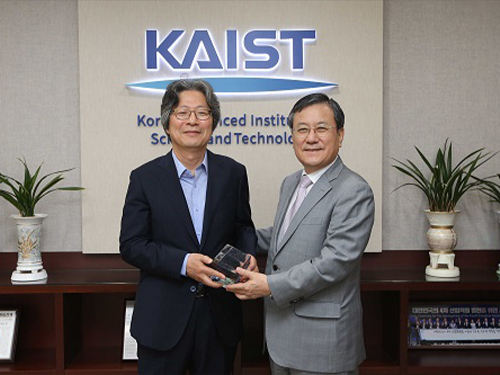 Distinguished Professor Koh Donates His Ho-Am Prize Money
(From left: Distinguished Professor Gou Young Koh and KAIST President Sung-Chul Shin)
Distinguished Professor Gou Young Koh from the Graduate School of Medical Science and Engineering donated one hundred million KRW to KAIST that he received for winning the Ho-Am Prize.
Professor Koh, who is widely renowned for angiogenesis, was appointed as the 2018 laureate of the 28th Ho-Am Prize for demonstrating the effective reduction of tumor progression and metastasis via tumor vessel normalization.
He made the donation to the Graduate School of Medical Science and Engineering, where he conducted his research. “As a basic medical scientist, it is my great honor to receive this prize for the recognition of my research outcome. I will give impetus to research for continuous development,” Professor Koh said.
Professor Koh also received the 5th Asan Award in Medicine in 2012 and the 7th Kyung-Ahm Award in 2011. He was also the awardee of the 17th Wunsch Medical Award. He has donated cash prizes to the school every time he is awarded.
KAIST President Sung-Chul Shin said, “I would like to express my gratitude to the professor for his generous donation to the school. It will be a great help fostering outstanding medical scientists.
Professor Koh received his MD-PhD from the Medical School of Chonbuk National University. After finishing his post-doctoral program at Cornell University and Indiana State University, he was appointed as a professor at Chonbuk National University and POSTECH. Currently, he holds the position of distinguished professor at KAIST and director of the IBS Center for Vascular Research.
2018.06.20 View 6437
Distinguished Professor Koh Donates His Ho-Am Prize Money
(From left: Distinguished Professor Gou Young Koh and KAIST President Sung-Chul Shin)
Distinguished Professor Gou Young Koh from the Graduate School of Medical Science and Engineering donated one hundred million KRW to KAIST that he received for winning the Ho-Am Prize.
Professor Koh, who is widely renowned for angiogenesis, was appointed as the 2018 laureate of the 28th Ho-Am Prize for demonstrating the effective reduction of tumor progression and metastasis via tumor vessel normalization.
He made the donation to the Graduate School of Medical Science and Engineering, where he conducted his research. “As a basic medical scientist, it is my great honor to receive this prize for the recognition of my research outcome. I will give impetus to research for continuous development,” Professor Koh said.
Professor Koh also received the 5th Asan Award in Medicine in 2012 and the 7th Kyung-Ahm Award in 2011. He was also the awardee of the 17th Wunsch Medical Award. He has donated cash prizes to the school every time he is awarded.
KAIST President Sung-Chul Shin said, “I would like to express my gratitude to the professor for his generous donation to the school. It will be a great help fostering outstanding medical scientists.
Professor Koh received his MD-PhD from the Medical School of Chonbuk National University. After finishing his post-doctoral program at Cornell University and Indiana State University, he was appointed as a professor at Chonbuk National University and POSTECH. Currently, he holds the position of distinguished professor at KAIST and director of the IBS Center for Vascular Research.
2018.06.20 View 6437 -
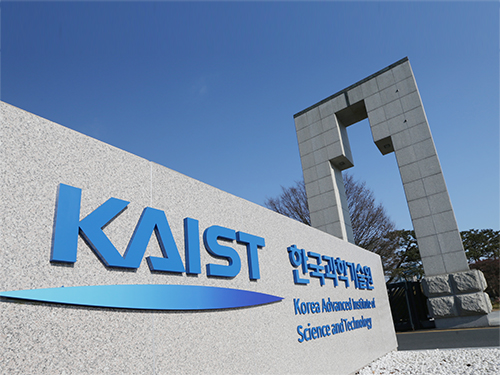 The Center for Anthropocene Studies (CAS) Opens
KAIST will start Anthropocene research, a convergence field of study, to address issues related to the commencement of human activities that have had scientific, industrial, and economic impacts on the Earth’s ecosystem. The National Research Foundation (NRF) of Korea endorsed the KAIST Center for Anthropocene Studies as its Convergence Research Center project.
Anthropocene refers to a new geological age in which various polluting materials that humans have made during the post-industrial revolution era have made a significant impact on the Earth and the lives of humankind. The studies expand the diverse socio-economic and environmental sectors for responding to climate change, natural disasters, ecological destruction, the polarization of the inequality and wealth, and many others.
The KAIST research group at the center, in collaboration with the Graduate School of Science and Technology Policy, the Graduate School of Culture Technology, the School of Humanities & Social Sciences, the Department of Industrial Design, the School of Electrical Engineering, the Satellite Technology Research Center (SaRTec), and the KAIST Initiative for Disaster Studies will conduct multidisciplinary research to address intriguing challenges with complex but creative approaches incorporating the fields of engineering, socioeconomics, and art.
The group will investigate topics such as▲ surface and marine changes to the Earth by applying satellite data ▲disaster prediction and governance system building through AI modeling ▲sustainable housing, transportation, and lifestyles ▲ engineering and artistic approaches for envisioning a new future for humankind and the Earth.
Professor Buhm Soon Park, who is in charge of the center, said, “This pioneering research work will inspire the re-creation of a new paradigm of convergence studies in science, engineering, humanities, and social science. We will contribute to making the world better by designing new technologies and social policies.
2018.06.05 View 14127
The Center for Anthropocene Studies (CAS) Opens
KAIST will start Anthropocene research, a convergence field of study, to address issues related to the commencement of human activities that have had scientific, industrial, and economic impacts on the Earth’s ecosystem. The National Research Foundation (NRF) of Korea endorsed the KAIST Center for Anthropocene Studies as its Convergence Research Center project.
Anthropocene refers to a new geological age in which various polluting materials that humans have made during the post-industrial revolution era have made a significant impact on the Earth and the lives of humankind. The studies expand the diverse socio-economic and environmental sectors for responding to climate change, natural disasters, ecological destruction, the polarization of the inequality and wealth, and many others.
The KAIST research group at the center, in collaboration with the Graduate School of Science and Technology Policy, the Graduate School of Culture Technology, the School of Humanities & Social Sciences, the Department of Industrial Design, the School of Electrical Engineering, the Satellite Technology Research Center (SaRTec), and the KAIST Initiative for Disaster Studies will conduct multidisciplinary research to address intriguing challenges with complex but creative approaches incorporating the fields of engineering, socioeconomics, and art.
The group will investigate topics such as▲ surface and marine changes to the Earth by applying satellite data ▲disaster prediction and governance system building through AI modeling ▲sustainable housing, transportation, and lifestyles ▲ engineering and artistic approaches for envisioning a new future for humankind and the Earth.
Professor Buhm Soon Park, who is in charge of the center, said, “This pioneering research work will inspire the re-creation of a new paradigm of convergence studies in science, engineering, humanities, and social science. We will contribute to making the world better by designing new technologies and social policies.
2018.06.05 View 14127 -
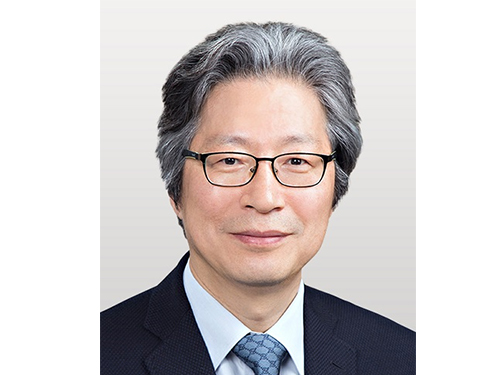 Professor Gou Young Koh, 2018 Laureate of Ho-Am Prize
Distinguished Professor Gou Young Koh from the Graduate School of Medical Science and Engineering was appointed a 2018 laureate in medicine of the Ho-Am Prize by the Ho-Am Foundation. Professor Koh is a renowned expert in the field of tumor angiogenesis by exploring the hidden nature of capillary and lymphatic vessels in human organs.
He was recognized for demonstrating the effective reduction of tumor progression and metastasis via tumor vessel normalization. This counterintuitive study result is regarded as a stepping stone for a drug discovery to prevent microvascular diseases.
Besides Professor Koh, Professor Hee Oh from Yale University (Science), Professor Nam-Gyu Park from Sungkyunkwan University (Engineering), Opera Singer Kwangchul Youn (The Arts) and Sister Carla Kang (Community Service) received awards.
The Ho-Am Prize is presented to individuals who have contributed to academics, the arts, and social development, or furthered the welfare of humanity, and commemorates the noble spirit of public service espoused by the late Chairman Byung-chull Lee, who used the pen name Ho-Am.
It was established in 1990 by Kun-Hee Lee, the chairman of Samsung. Awards have been presented to 143 individuals worth a total of 24.4 billion KRW.
2018.04.11 View 9577
Professor Gou Young Koh, 2018 Laureate of Ho-Am Prize
Distinguished Professor Gou Young Koh from the Graduate School of Medical Science and Engineering was appointed a 2018 laureate in medicine of the Ho-Am Prize by the Ho-Am Foundation. Professor Koh is a renowned expert in the field of tumor angiogenesis by exploring the hidden nature of capillary and lymphatic vessels in human organs.
He was recognized for demonstrating the effective reduction of tumor progression and metastasis via tumor vessel normalization. This counterintuitive study result is regarded as a stepping stone for a drug discovery to prevent microvascular diseases.
Besides Professor Koh, Professor Hee Oh from Yale University (Science), Professor Nam-Gyu Park from Sungkyunkwan University (Engineering), Opera Singer Kwangchul Youn (The Arts) and Sister Carla Kang (Community Service) received awards.
The Ho-Am Prize is presented to individuals who have contributed to academics, the arts, and social development, or furthered the welfare of humanity, and commemorates the noble spirit of public service espoused by the late Chairman Byung-chull Lee, who used the pen name Ho-Am.
It was established in 1990 by Kun-Hee Lee, the chairman of Samsung. Awards have been presented to 143 individuals worth a total of 24.4 billion KRW.
2018.04.11 View 9577 -
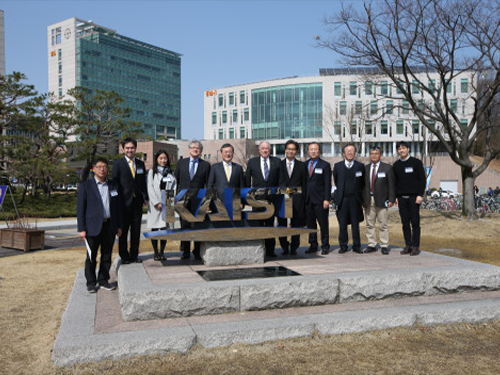 Nobel Laureates Brighten the Conversation at Global Leaders Forum
Two Nobel laureates who participated in the President’s Advisory Council joined the Global Leaders Forum as plenary speakers at KAIST on March 22. The forum highlighted the 25 events which were held during the Vision Week in celebration of the Vision 2031 Declaration Ceremony on March 20.
(President of KAIST Sung-Chul Shin, making welcoming remarks)
The Global Leaders Forum, titled “Scientific Discovery and Creativity,’ brought two prominent Nobel laureates in physics and chemistry. Dr. Klaus von Klitzing from the Max-Planck Institute for Solid State Research and Dr. Kurt Wüthrich from ETH Zürich inspired more than 300 audience members, including many young scholars, at Fusion Hall.
(Dr. Klaus von Klitzing from the Max-Planck Institute for Solid State Research)
Dr. Klitzing received the prize in 1985 in recognition of his discovery of the ‘integer quantum Hall effect.’ Meanwhile Dr. Wüthrich was awarded in 2002 for ‘"the development of Nuclear Magnetic Resonance methods for the determination of protein structures in solution."
Not only did they share their journey that led to the Nobel Prize, but also disclosed their personal stories that can relate to KAIST students as they pursue their scientific careers.
Many of the questions raised pertained to ‘creativity’ and ‘failure’: what is creativity and how to improve it and what is failure and how to deal with it. Dr. Klitzing replied, “If you want to go to a new direction, ask yourself inner question: what you really want to do.”
(From left: Dr. Klaus von Klitzing and Dr. Kurt Wüthrich from ETH Zürich)
Meanwhile, Dr. Wüthrich advised to set your goal first, before you start your research. “We tend to romanticize the creativity and it can be simulated. But it hardly does. It is important to know your goal first and set it appropriately.”
“Define failure as a process to learn something new, then you can comfortably move on,” he suggested in dealing with failure. “In many cases, the great achievement sometimes happens accidentally not intentionally. Maybe, you can see one success after 100 failures in the experiments. Nobody can predict the Nobel Prize quantitatively. Set the goal, and go to international conferences frequently if possible and evaluate where you are, compared with your international peers. Then, you can modify your goal and pursue what you want to do. Foremost, just enjoy your scientific work you are working with. That’s all. There’s no secret in the Nobel Prize.”
Since artificial intelligence is taking over people’s job, there’s also the question whether the concept of creativity should be modified due to technology development.
Regarding this question, Dr. von Klitzing made a strong point that the concept of creativity stays the same. He said that creativity is something new; in that sense, computers can never be creative because they use present, existing knowledge.
There was also a surprising moment. Dr. Wűthrich, who earned a bachelor’s degree in chemistry, physics, and mathematics, revealed to the audiences that his dream used to be a football player, not a scientist. He injured his foot, which prevented him from playing soccer, and that caused him to choose another career path.
Both laureates highlighted the importance of a positive attitude for their dreams and an open mindset for their colleagues and field of study.
Dr. von Klitzing pointed out that asking new questions can be the foundation of creativity. Hence, he urged students to be open minded and try to interact with one another.
Dr. Wűthrich commented that it is the job of professors to expand the view of students and guide younger generations. For young scientists, they should keep in mind that failure is something positive and that having an optimistic attitude is crucial.
(President of KAIST Sung-Chul Shin with the panelists and Dean of KAIST Academy Tae-Eog Lee)
(Interview of Dr. Kurt Wüthrich)
2018.03.27 View 4741
Nobel Laureates Brighten the Conversation at Global Leaders Forum
Two Nobel laureates who participated in the President’s Advisory Council joined the Global Leaders Forum as plenary speakers at KAIST on March 22. The forum highlighted the 25 events which were held during the Vision Week in celebration of the Vision 2031 Declaration Ceremony on March 20.
(President of KAIST Sung-Chul Shin, making welcoming remarks)
The Global Leaders Forum, titled “Scientific Discovery and Creativity,’ brought two prominent Nobel laureates in physics and chemistry. Dr. Klaus von Klitzing from the Max-Planck Institute for Solid State Research and Dr. Kurt Wüthrich from ETH Zürich inspired more than 300 audience members, including many young scholars, at Fusion Hall.
(Dr. Klaus von Klitzing from the Max-Planck Institute for Solid State Research)
Dr. Klitzing received the prize in 1985 in recognition of his discovery of the ‘integer quantum Hall effect.’ Meanwhile Dr. Wüthrich was awarded in 2002 for ‘"the development of Nuclear Magnetic Resonance methods for the determination of protein structures in solution."
Not only did they share their journey that led to the Nobel Prize, but also disclosed their personal stories that can relate to KAIST students as they pursue their scientific careers.
Many of the questions raised pertained to ‘creativity’ and ‘failure’: what is creativity and how to improve it and what is failure and how to deal with it. Dr. Klitzing replied, “If you want to go to a new direction, ask yourself inner question: what you really want to do.”
(From left: Dr. Klaus von Klitzing and Dr. Kurt Wüthrich from ETH Zürich)
Meanwhile, Dr. Wüthrich advised to set your goal first, before you start your research. “We tend to romanticize the creativity and it can be simulated. But it hardly does. It is important to know your goal first and set it appropriately.”
“Define failure as a process to learn something new, then you can comfortably move on,” he suggested in dealing with failure. “In many cases, the great achievement sometimes happens accidentally not intentionally. Maybe, you can see one success after 100 failures in the experiments. Nobody can predict the Nobel Prize quantitatively. Set the goal, and go to international conferences frequently if possible and evaluate where you are, compared with your international peers. Then, you can modify your goal and pursue what you want to do. Foremost, just enjoy your scientific work you are working with. That’s all. There’s no secret in the Nobel Prize.”
Since artificial intelligence is taking over people’s job, there’s also the question whether the concept of creativity should be modified due to technology development.
Regarding this question, Dr. von Klitzing made a strong point that the concept of creativity stays the same. He said that creativity is something new; in that sense, computers can never be creative because they use present, existing knowledge.
There was also a surprising moment. Dr. Wűthrich, who earned a bachelor’s degree in chemistry, physics, and mathematics, revealed to the audiences that his dream used to be a football player, not a scientist. He injured his foot, which prevented him from playing soccer, and that caused him to choose another career path.
Both laureates highlighted the importance of a positive attitude for their dreams and an open mindset for their colleagues and field of study.
Dr. von Klitzing pointed out that asking new questions can be the foundation of creativity. Hence, he urged students to be open minded and try to interact with one another.
Dr. Wűthrich commented that it is the job of professors to expand the view of students and guide younger generations. For young scientists, they should keep in mind that failure is something positive and that having an optimistic attitude is crucial.
(President of KAIST Sung-Chul Shin with the panelists and Dean of KAIST Academy Tae-Eog Lee)
(Interview of Dr. Kurt Wüthrich)
2018.03.27 View 4741 -
 Three Professors Named KAST Fellows
(Professor Dan Keun Sung at the center)
(Professor Y.H. Cho at the center)
(Professor K.H. Cho at the center)
The Korean Academy of Science and Technology (KAST) inducted three KAIST professors as fellows at the New Year’s ceremony held at KAST on January 12. They were among the 24 newly elected fellows of the most distinguished academy in Korea. The new fellows are Professor Dan Keun Sung of the School of Electrical Engineering, Professor Kwang-Hyun Cho of the Department of Bio and Brain Engineering, and Professor Yong-Hoon Cho of the Department of Physics.
Professor Sung was recognized for his lifetime academic achievements in fields related with network protocols and energy ICT. He also played a crucial role in launching the Korean satellites KITSAT-1,2,3 and the establishment of the Satellite Technology Research Center at KAIST.
Professor Y.H.Cho has been a pioneer in the field of low-dimensional semiconductor-powered quantum photonics that enables quantum optical research in solid state. He has been recognized as a renowned scholar in this field internationally.
Professor K.H.Cho has conducted original research that combines IT and BT in systems biology and has applied novel technologies of electronic modeling and computer simulation analysis for investigating complex life sciences. Professor Cho, who is in his 40s, is the youngest fellow among the newly inducted fellows.
2018.01.16 View 16481
Three Professors Named KAST Fellows
(Professor Dan Keun Sung at the center)
(Professor Y.H. Cho at the center)
(Professor K.H. Cho at the center)
The Korean Academy of Science and Technology (KAST) inducted three KAIST professors as fellows at the New Year’s ceremony held at KAST on January 12. They were among the 24 newly elected fellows of the most distinguished academy in Korea. The new fellows are Professor Dan Keun Sung of the School of Electrical Engineering, Professor Kwang-Hyun Cho of the Department of Bio and Brain Engineering, and Professor Yong-Hoon Cho of the Department of Physics.
Professor Sung was recognized for his lifetime academic achievements in fields related with network protocols and energy ICT. He also played a crucial role in launching the Korean satellites KITSAT-1,2,3 and the establishment of the Satellite Technology Research Center at KAIST.
Professor Y.H.Cho has been a pioneer in the field of low-dimensional semiconductor-powered quantum photonics that enables quantum optical research in solid state. He has been recognized as a renowned scholar in this field internationally.
Professor K.H.Cho has conducted original research that combines IT and BT in systems biology and has applied novel technologies of electronic modeling and computer simulation analysis for investigating complex life sciences. Professor Cho, who is in his 40s, is the youngest fellow among the newly inducted fellows.
2018.01.16 View 16481 -
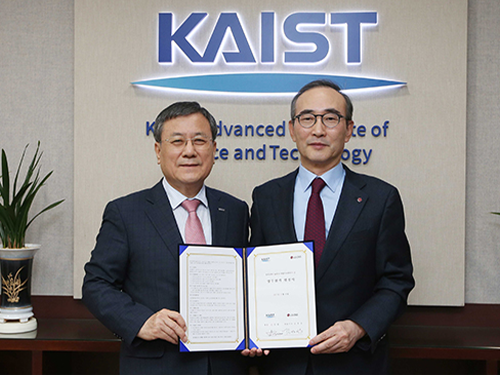 Strengthening Industry-Academia Cooperation with LG CNS
On November 20, KAIST signed an MoU with LG CNS for industry-academia partnership in education, research, and business in the fields of AI and Big Data. Rather than simply developing education programs or supporting industry-academia scholarships, both organizations agreed to carry out a joint research project on AI and Big Data that can be applied to practical business.
KAIST will collaborate with LG CNS in the fields of smart factories, customer analysis, and supply chain management analysis.
Not only will LG CNS offer internships to KAIST students, but it also will support professors and students who propose innovative startup ideas for AI and Big Data. Offering an industry-academia scholarship for graduate students is also being discussed. Together with LG CNS, KAIST will put its efforts into propose projects regarding AI and Big Data in the public sector.
Furthermore, KAIST and LG CNS will jointly explore and carry out industry-academia projects that could be practically used in business. Both will carry out the project vigorously through strong cooperation; for instance, LG CNS employees can be assigned to KAIST, if necessary. Also, LG CNS’s AI and Big Data platform, called DAP (Data Analytics & AI Platform) will be used as a data analysis tool during the project and the joint outcomes will be installed in DAP.
KAIST professors with expertise in AI deep learning have trained LG CNS employees since the Department of Industrial & Systems Engineering established ‘KAIST AI Academy’ in LG CNS last August.
“With KAIST, the best research-centered university in Korea, we will continue to lead in developing the field of AI and Big Data and provide innovative services that create value by connecting them to customer business,” Yong Shub Kim, the CEO of LG CNS, highlighted.
2017.11.22 View 13397
Strengthening Industry-Academia Cooperation with LG CNS
On November 20, KAIST signed an MoU with LG CNS for industry-academia partnership in education, research, and business in the fields of AI and Big Data. Rather than simply developing education programs or supporting industry-academia scholarships, both organizations agreed to carry out a joint research project on AI and Big Data that can be applied to practical business.
KAIST will collaborate with LG CNS in the fields of smart factories, customer analysis, and supply chain management analysis.
Not only will LG CNS offer internships to KAIST students, but it also will support professors and students who propose innovative startup ideas for AI and Big Data. Offering an industry-academia scholarship for graduate students is also being discussed. Together with LG CNS, KAIST will put its efforts into propose projects regarding AI and Big Data in the public sector.
Furthermore, KAIST and LG CNS will jointly explore and carry out industry-academia projects that could be practically used in business. Both will carry out the project vigorously through strong cooperation; for instance, LG CNS employees can be assigned to KAIST, if necessary. Also, LG CNS’s AI and Big Data platform, called DAP (Data Analytics & AI Platform) will be used as a data analysis tool during the project and the joint outcomes will be installed in DAP.
KAIST professors with expertise in AI deep learning have trained LG CNS employees since the Department of Industrial & Systems Engineering established ‘KAIST AI Academy’ in LG CNS last August.
“With KAIST, the best research-centered university in Korea, we will continue to lead in developing the field of AI and Big Data and provide innovative services that create value by connecting them to customer business,” Yong Shub Kim, the CEO of LG CNS, highlighted.
2017.11.22 View 13397 -
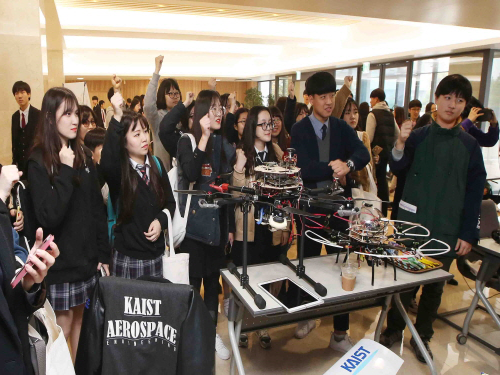 KAST Opened the Campus to the Public
KAIST hosted OPEN KAIST 2017 on the main campus from November 2 to 3, 2017. OPEN KAIST is a science and cultural event designed for students and the general public to experience and take a glance at research labs.
More than 10,000 visitors came to KAIST this year. Groups of families and students came to KAIST to experience various programs related to science.
Twenty departments, including Mechanical Engineering, Aerospace Engineering, the Graduate School of Cultural Technology, and Materials Science and Engineering participated in the event, along with three research centers and the Public Relations Office.
The event was composed of a total of 70 programs in four sections: lab tour, research performance exhibition, department introduction, and special lectures.
The kick off activity for the event was a trial game of the AI World Cup 2017 which will be hosted by KAIST in December 2017. Many people also visited the mobile health care showroom where they could experience what a future smart home and hospital would look like. It was also interesting to visit a futuristic living space for one-person households that provides virtual reality services.
KAIST hopes that the event offers an opportunity for children and students to get to know about science better. Professor Jong-Hwan Kim, the Dean of the College of Engineering at KAIST said, “OPEN KAIST is the one and only opportunity to visit and experience our research labs. KAIST will make every effort to take a step closer to the public by focusing on research that contributes to human society.”
2017.11.06 View 8249
KAST Opened the Campus to the Public
KAIST hosted OPEN KAIST 2017 on the main campus from November 2 to 3, 2017. OPEN KAIST is a science and cultural event designed for students and the general public to experience and take a glance at research labs.
More than 10,000 visitors came to KAIST this year. Groups of families and students came to KAIST to experience various programs related to science.
Twenty departments, including Mechanical Engineering, Aerospace Engineering, the Graduate School of Cultural Technology, and Materials Science and Engineering participated in the event, along with three research centers and the Public Relations Office.
The event was composed of a total of 70 programs in four sections: lab tour, research performance exhibition, department introduction, and special lectures.
The kick off activity for the event was a trial game of the AI World Cup 2017 which will be hosted by KAIST in December 2017. Many people also visited the mobile health care showroom where they could experience what a future smart home and hospital would look like. It was also interesting to visit a futuristic living space for one-person households that provides virtual reality services.
KAIST hopes that the event offers an opportunity for children and students to get to know about science better. Professor Jong-Hwan Kim, the Dean of the College of Engineering at KAIST said, “OPEN KAIST is the one and only opportunity to visit and experience our research labs. KAIST will make every effort to take a step closer to the public by focusing on research that contributes to human society.”
2017.11.06 View 8249 -
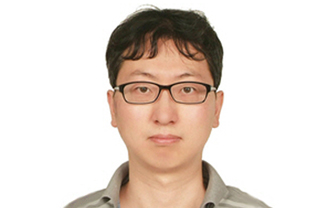 Professor Lee Recognized by the KMS as Best Paper Awardee
Professor Ji Oon Lee of the Department of Mathematical Sciences was selected as the 2017 Best Paper Awardee by the Korean Mathematical Society. The award will be presented during the KMS spring meeting on April 29. Dr. Lee is being honored for proving a necessary and sufficient condition for the Tracy-Wisdom law of Wigner matrices. In a paper titled ‘A Necessary and Sufficient Condition for Edge Universality of Wigner Matrices,’ he proposed a solution for one of the many unanswered problems in the field of random matrix theory that have existed for decades. The paper, co-authored with Professor Jun Yin at the University of Wisconsin – Madison, was published in the Duke Mathematical Journal in 2014. Professor Lee joined KAIST in 2010 after finishing his Ph.D. at Harvard University. He was named a ‘POSCI Science Fellow’ and received the ‘Young Scientist Award’ from the KMS in 2014.
2017.04.27 View 11016
Professor Lee Recognized by the KMS as Best Paper Awardee
Professor Ji Oon Lee of the Department of Mathematical Sciences was selected as the 2017 Best Paper Awardee by the Korean Mathematical Society. The award will be presented during the KMS spring meeting on April 29. Dr. Lee is being honored for proving a necessary and sufficient condition for the Tracy-Wisdom law of Wigner matrices. In a paper titled ‘A Necessary and Sufficient Condition for Edge Universality of Wigner Matrices,’ he proposed a solution for one of the many unanswered problems in the field of random matrix theory that have existed for decades. The paper, co-authored with Professor Jun Yin at the University of Wisconsin – Madison, was published in the Duke Mathematical Journal in 2014. Professor Lee joined KAIST in 2010 after finishing his Ph.D. at Harvard University. He was named a ‘POSCI Science Fellow’ and received the ‘Young Scientist Award’ from the KMS in 2014.
2017.04.27 View 11016 -
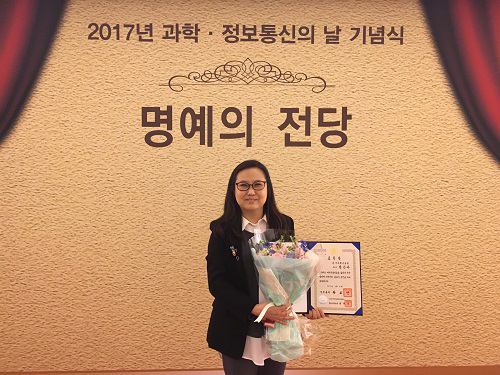 Professor Jinah Park Received the Prime Minister's Award
Professor Jinah Park of the School of Computing received the Prime Minister’s Citation Ribbon on April 21 at a ceremony celebrating the Day of Science and ICT. The awardee was selected by the Ministry of Science, ICT and Future Planning and Korea Communications Commission.
Professor Park was recognized for her convergence R&D of a VR simulator for dental treatment with haptic feedback, in addition to her research on understanding 3D interaction behavior in VR environments. Her major academic contributions are in the field of medical imaging, where she developed a computational technique to analyze cardiac motion from tagging data.
Professor Park said she was very pleased to see her twenty-plus years of research on ways to converge computing into medical areas finally bear fruit. She also thanked her colleagues and students in her Computer Graphics and CGV Research Lab for working together to make this achievement possible.
2017.04.26 View 11509
Professor Jinah Park Received the Prime Minister's Award
Professor Jinah Park of the School of Computing received the Prime Minister’s Citation Ribbon on April 21 at a ceremony celebrating the Day of Science and ICT. The awardee was selected by the Ministry of Science, ICT and Future Planning and Korea Communications Commission.
Professor Park was recognized for her convergence R&D of a VR simulator for dental treatment with haptic feedback, in addition to her research on understanding 3D interaction behavior in VR environments. Her major academic contributions are in the field of medical imaging, where she developed a computational technique to analyze cardiac motion from tagging data.
Professor Park said she was very pleased to see her twenty-plus years of research on ways to converge computing into medical areas finally bear fruit. She also thanked her colleagues and students in her Computer Graphics and CGV Research Lab for working together to make this achievement possible.
2017.04.26 View 11509